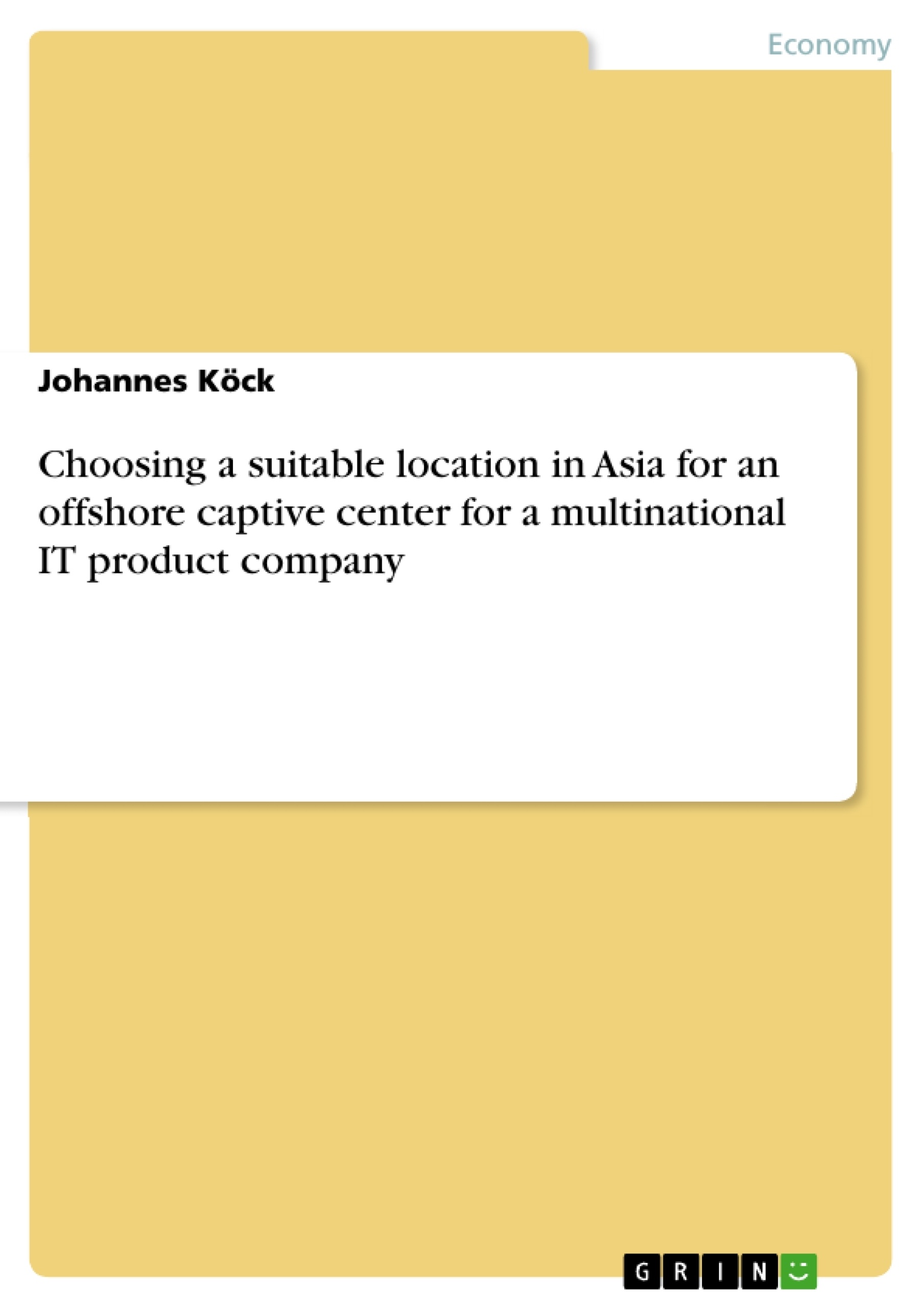Firstly, a differentiation between an IT product company and an IT service company will be conducted. Afterwards, the term “offshore captive center” will be defined. Thirdly, factors for establishing a captive center will be determined. Last but not least, one Asian city is supposed to be chosen for setting up an IT captive center.
Table of Contents
- IT service companies vs. IT product companies
- Definition “offshore captive center”
- Choosing a suitable location
- Tier 1 locations
- Tier 2 locations
- Tier 3 locations
Objectives and Key Themes
This assignment aims to identify a suitable city in Asia for establishing an offshore captive center for an IT product multinational company. It begins by differentiating between IT product and service companies, defining "offshore captive center," and identifying key factors for location selection. Finally, it proposes a specific Asian city for the captive center.
- Distinction between IT service and product companies
- Characteristics and advantages of offshore captive centers
- Factors influencing the selection of an offshore location
- Comparative analysis of potential Indian cities for captive center establishment
- Justification for the chosen city based on specific criteria
Chapter Summaries
IT service companies vs. IT product companies: This chapter distinguishes between IT service and product companies. Service companies develop software tailored to customer needs, often charging hourly or fixed prices. Product companies, in contrast, develop and sell pre-defined software products, with client input affecting features but not the overall design. The chapter uses SAP as an example of an IT product company, highlighting the key difference in their business models and client interaction.
Definition “offshore captive center”: This chapter defines an offshore captive center as the relocation of a business process to a foreign subsidiary. This strategy is often used by large companies to leverage lower wages while retaining internal control of expertise and preventing knowledge loss to external entities. The definition emphasizes the internal nature of the relocation within the company structure, contrasting it with outsourcing to third-party providers.
Choosing a suitable location: This chapter explores factors relevant to choosing an offshore location, focusing on India due to its large IT services supply and skilled workforce. The chapter discusses India's post-independence focus on education (including the IITs) and the role of fiber optics in enabling remote work, contributing to its rise as an offshoring hub. A comparison of different tiers of Indian cities (Tier 1, Tier 2, Tier 3) is presented, weighing factors such as infrastructure, talent pool, and cost of living. The chapter ultimately recommends a Tier 1 city due to access to skilled labor and established IT clusters.
Keywords
Offshore captive center, IT product company, IT service company, India, offshoring, location selection, Hyderabad, Tier 1 city, talent pool, infrastructure, cost of living, IT industry, A.T. Kearney Global Service Location Index.
FAQ: Comprehensive Language Preview - Offshore Captive Center in Asia
What is the main objective of this document?
This document aims to identify a suitable Asian city for establishing an offshore captive center for an IT product multinational company. It analyzes key factors for location selection, differentiating between IT product and service companies and defining "offshore captive center" along the way.
What is the difference between IT service and IT product companies?
IT service companies develop software tailored to individual client needs, often charging hourly or fixed prices. IT product companies develop and sell pre-defined software products. Client input may influence features, but not the overall design. SAP is cited as an example of an IT product company.
What is an "offshore captive center"?
An offshore captive center is the relocation of a business process to a foreign subsidiary. Large companies use this strategy to leverage lower wages while maintaining internal control of expertise and preventing knowledge loss to external entities. It's different from outsourcing to a third-party provider because it remains internal to the company structure.
What factors influence the selection of an offshore location (specifically focusing on India)?
Key factors include access to a skilled workforce, robust infrastructure, cost of living, and the overall business environment. India is highlighted due to its large IT services supply and a skilled workforce developed through a post-independence focus on education (including the IITs) and the advancement of fiber optics enabling remote work. The document explores different tiers of Indian cities (Tier 1, 2, and 3) based on these factors.
What are the different tiers of Indian cities considered and why?
The document categorizes Indian cities into three tiers (Tier 1, Tier 2, and Tier 3). Tier 1 cities are preferred due to access to a larger skilled labor pool and established IT clusters. The analysis considers infrastructure, talent pool, and cost of living when comparing these tiers.
Which type of city is ultimately recommended and why?
A Tier 1 city in India is recommended due to its access to a skilled workforce and established IT clusters. While the specific city isn't explicitly named in this preview, the analysis lays the groundwork for such a recommendation.
What keywords are associated with this document?
Offshore captive center, IT product company, IT service company, India, offshoring, location selection, Hyderabad (implied as a potential location), Tier 1 city, talent pool, infrastructure, cost of living, IT industry, A.T. Kearney Global Service Location Index.
What is included in the document's "Chapter Summaries"?
The chapter summaries provide a concise overview of the distinctions between IT service and product companies, a detailed definition of offshore captive centers, and a comprehensive discussion on the factors involved in choosing a suitable offshore location, with a specific focus on India and its tiered city system.
- Quote paper
- Johannes Köck (Author), 2013, Choosing a suitable location in Asia for an offshore captive center for a multinational IT product company, Munich, GRIN Verlag, https://www.grin.com/document/378116




